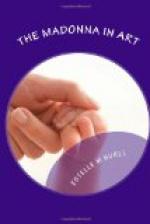[Illustration: FILIPPO LIPPI.—MADONNA IN ADORATION.]
In the Madonna of the Uffizi, he broke away somewhat from tradition, and rendered quite a new version of the subject. The Virgin is seated with folded hands, adoring her child, who is held up before her by two boy angels. His type of childhood is by no means pretty, though altogether natural. The Virgin cannot be called either intellectual or spiritual, but “where,” as a noted critic has asked, “can we find a face more winsome and appealing?” Certainly she is a lovely woman, and
“If you get simple beauty
and naught else,
That’s somewhat:
and you’ll find the soul you have missed
Within yourself, when you
return him thanks.”
The idea of the seated Madre Pia, comparatively rare in Florentine art, is quite frequent in northern Italy. Sometimes the setting is a landscape, in the foreground of which the Madonna sits adoring the babe lying on her lap. Examples are by Basaiti (Paduan), in the National Gallery, and by a painter of Titian’s school, in Berlin. Much more common is the enthroned Madonna in Adoration, and for this we may turn to the pictures of the Vivarini, Bartolommeo and Luigi, or Alvise. These men were of Muranese origin, and in the very beginning of Venetian art-history were at the head of their profession, until finally eclipsed by the rival family of the Bellini. Among their works, we find by each one at least three pictures of the type described. As the most worthy of description, we may select the altar-piece by Luigi, in the Church of the Redentore. As it is one of the most popular Madonnas in Venice, no collection is complete without it. A green curtain forms the background, against which the plain marble throne-chair is brought into relief. The Virgin sits wrapt in her own thoughts, an impersonation of tranquil dignity. A heavy wimple falls low over her forehead, entirely concealing her hair, and with its severe simplicity accentuating the chaste beauty of her face. Two fascinating little cherubs sit on a parapet in front, playing on lutes; and, lulled by their gentle music, the sweet babe sleeps on, serenely unconscious of it all.
[Illustration: LUIGI VIVARINI.—MADONNA AND CHILD.]
Before such pictures as this, gleaming in the dim light of quiet chapels, many a heart, before unbelieving, may learn a new reverence for the mysterious sanctity of motherhood.




